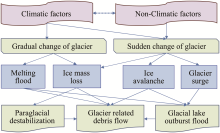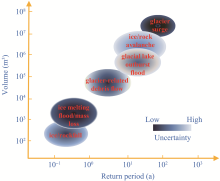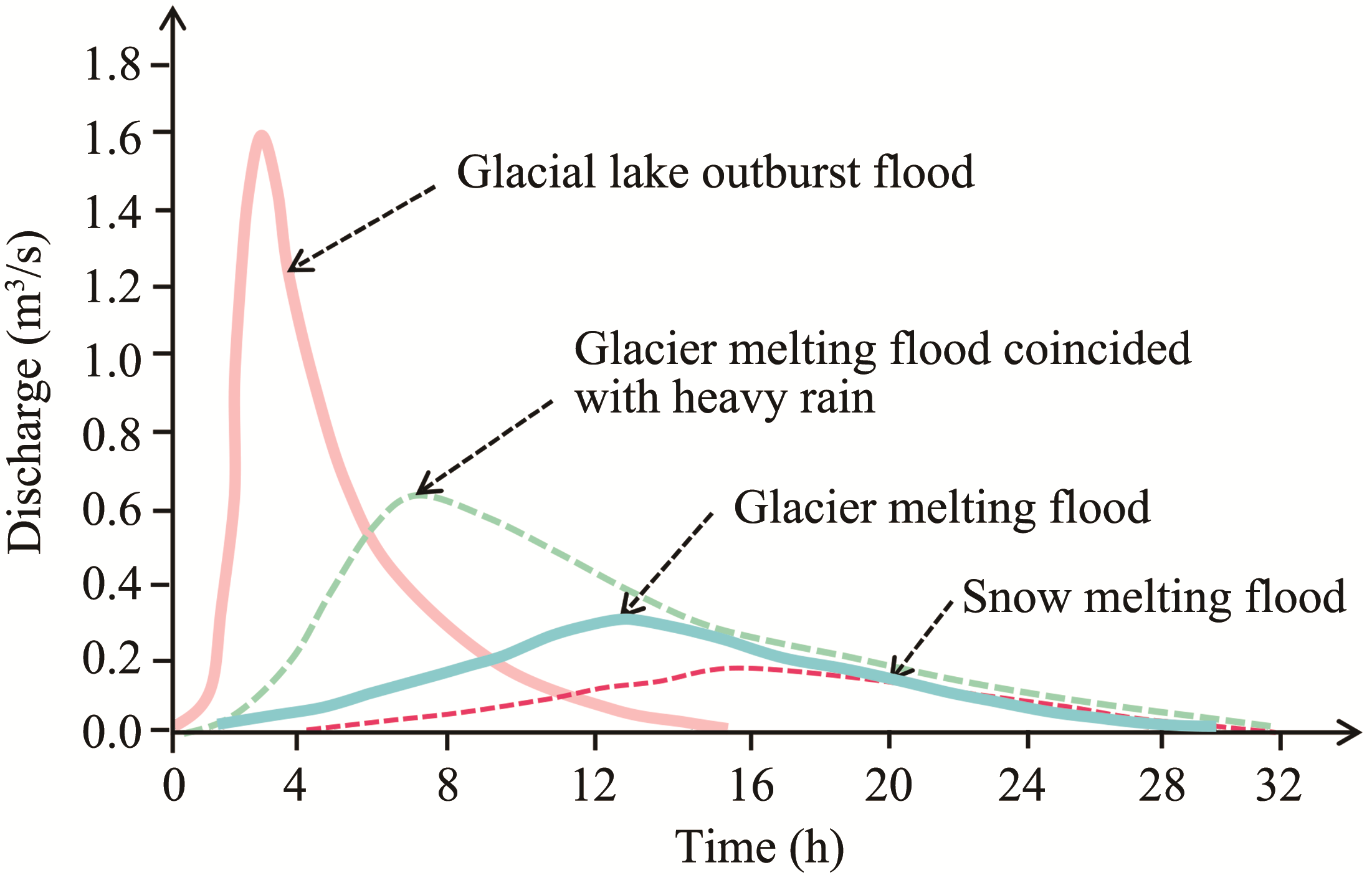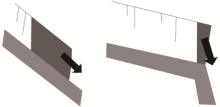Sciences in Cold and Arid Regions ›› 2020, Vol. 12 ›› Issue (6): 436–446.doi: 10.3724/SP.J.1226.2020.00436
Manifestations and mechanisms of mountain glacier-related hazards
Xin Wang1( ),Qiao Liu2,ShiYin Liu3,GuangLi He1
),Qiao Liu2,ShiYin Liu3,GuangLi He1
- 1.School of Resource Environment and Safety Engineering, Hunan University of Science and Technology, Xiangtan, Hunan 411100, China
2.Institute of Mountain Hazards and Environment, Chinese Academy of Sciences, Chengdu, Sichuan 610000, China
3.Institute of International Rivers and Eco-Security, Yunnan University, Kunming, Yunnan 650091, China
|
Alean J, 1985. Ice avalanches: some empirical information about their formation and reach. Journal of Glaciology, 31(109): 324-333. DOI: 10.3189/s0022143000006663.
doi: 10.3189/s0022143000006663 |
|
|
Allen SK, Cox SC, Owens LF, 2011. Rock avalanches and other landslides in the central Southern Alps of New Zealand: a regional study considering possible climate change impacts. Landslides, 8(1): 33-48. DOI: 10.1007/s10346-010-0222-z.
doi: 10.1007/s10346-010-0222-z |
|
|
Allen SK, Zhang GQ, Wang WC, et al., 2019. Potentially dangerous glacial lakes across the Tibetan Plateau revealed using a large-scale automated assessment approach. Science Bulletin, 64(7): 435-445. DOI: 10.1016/j.scib.2019.03.011.
doi: 10.1016/j.scib.2019.03.011 |
|
|
Benn DI, Fowler AC, Hewitt L, et al., 2019. A general theory of glacier surges. Journal of Glaciology, 65(253): 701-716. DOI: 10.1017/jog.2019.62.
doi: 10.1017/jog.2019.62 |
|
| Benn D, Evans DJA, 2010. Glaciers and Glaciation. London: Saffron House, 2nd Edition, pp: 57-106. | |
|
Bhambri R, Hewitt K, Kawishwar P, et al., 2017. Surge-type and surge-modified glaciers in the Karakoram. Scientific Reports, 7(1): 1-14. DOI: 10.1038/s41598-017-15473-8.
doi: 10.1038/s41598-017-15473-8 |
|
|
Bhambri R, Watson CS, Hewitt K, et al., 2020. The hazardous 2017-2019 surge and river damming by Shispare Glacier, Karakoram. Scientific reports, 10(1): 1-14. DOI: 10.1038/s41598-020-61277-8.
doi: 10.1038/s41598-020-61277-8 |
|
|
Björnsson H, 1998. Hydrological characteristics of the drainage system beneath a surging glacier. Nature, 395: 771-774. DOI: 10.1038/27384.
doi: 10.1038/27384 |
|
|
Björnsson H, Pálsson F, Sigurđsson O, et al., 2003. Surges of glaciers in Iceland. Annals of Glaciology, 36: 82-90. DOI: 10.3189/172756403781816365.
doi: 10.3189/172756403781816365 |
|
|
Bolch T, Kulkarni A, Kääb A, et al., 2012. The state and fate of Himalayan glaciers. Science, 336(6079): 310-314. DOI: 10.1126/science.1215828.
doi: 10.1126/science.1215828 |
|
|
Carrivick JL, Tweed FS, 2016. A global assessment of the societal impacts of glacier outburst floods. Global and Planetary Change, 144: 1-16. DOI: 10.1016/j.gloplacha.2016. 07.001.
doi: 10.1016/j.gloplacha.2016. 07.001 |
|
|
Raymond CF, 1987. How do glaciers surge? A review. Journal of Geophysical Research, 92(B9): 9121-9134. DOI: 10. 1029/JB092iB09p09121.
doi: 10. 1029/JB092iB09p09121 |
|
|
Chiarle M, Iannotti S, Mortara G, et al., 2007. Recent debris flow occurrences associated with glaciers in the Alps. Global and Planetary Change, 56(1-2): 123-136. DOI: 10.1016/j.gloplacha.2006.07.003.
doi: 10.1016/j.gloplacha.2006.07.003 |
|
|
Clarke GKC, Hambrey MJ, 2019. Structural evolution during cyclic glacier surges: 2. Numerical modeling. Journal of Geophysical Research: Earth Surface, 124(2): 495-525. DOI: 10.1029/2018jf004870.
doi: 10.1029/2018jf004870 |
|
| Cuffey KM, Paterson WSB, 2010. The Physics of Glaciers (fourth edition). Oxford: Elsevier Science Ltd., pp. 137-173. | |
|
Cui P, Chen XQ, Cheng ZL, et al., 2010. Monitoring and prevention of debris-flows and landslides in Tibet. Chinese Journal of Nature, 32 (1): 19-25. DOI: 10.3969/j.issn.0253-9608.2010.01.005. (in Chinese)
doi: 10.3969/j.issn.0253-9608.2010.01.005. |
|
|
Dehecq A, Gourmelen N, Gardner AS, et al., 2019. Twenty-first century glacier slowdown driven by mass loss in High Mountain Asia. Nature Geoscience, 12(1): 22-27. DOI: 10.1038/s41561-018-0271-9.
doi: 10.1038/s41561-018-0271-9 |
|
| Deng YX, 1988. Glacial debris-flow and glacial lake outburst flood in China. In:Shi Y (ed.. | |
| An Introduction to the Glaciers in China. Beijing: Science Press, pp. 205-221. | |
|
Evans SG, Clague JJ, 1994. Recent climatic change and catastrophic geomorphic processes in mountain environments. Geomorphology, 10: 107-128. DOI:10.1016/0169-555x(94)90011-6.
doi: 10.1016/0169-555x(94)90011-6 |
|
| Evans SG, Delaney KB, 2015. Catastrophic Mass Flows in the Mountain Glacial Environment, in Snow and Ice-Related Hazards, Risks, and Disasters, In: Haeberli W, Whiteman C, (eds.). Pittsburgh: Elsevier, pp. 563-606. | |
|
Faillettaz J, Funk M, Vincent C, 2015. Avalanching glacier instabilities: Review on processes and early warning perspectives. Reviews of Geophysics, 53(2): 203-224. DOI: 10. 1002/2014rg000466.
doi: 10. 1002/2014rg000466 |
|
|
Faillettaz J, Funk M, Sornette D, 2012. Instabilities on Alpine temperate glaciers: new insights arising from the numerical modelling of Allalingletscher (Valais, Switzerland). Natural Hazards and Earth System Sciences, 12(9): 2977-2991. DOI:10.5194/nhess-12-2977-2012.
doi: 10.5194/nhess-12-2977-2012 |
|
|
Fischer L, Eisenbeiss H, Kääb A, et al., 2011. Monitoring topographic changes in a periglacial high‐mountain face using high‐resolution DTMs, Monte Rosa East Face, Italian Alps. Permafrost and Periglacial Processes, 22(2): 140-152. DOI: 10.1002/pp.717.
doi: 10.1002/pp.717 |
|
|
Fischer L, Huggel C, Kääb A, et al., 2013. Slope failures and erosion rates on a glacierized high‐mountain face under climatic changes. Earth Surface Processes and Landforms, 38(8): 836-846. DOI: 10.1002/esp.3355.
doi: 10.1002/esp.3355 |
|
|
Fujita K, Nuimura T, 2011. Spatially heterogeneous wastage of Himalayan glaciers. Proceedings of the National Academy of Sciences, 108(34): 14011-14014. DOI: 10.1073/pnas. 1106242108.
doi: 10.1073/pnas. 1106242108 |
|
|
Fujita K, Inoue H, Izumi T, et al., 2017. Anomalous winter-snow-amplified earthquake-induced disaster of the 2015 Langtang avalanche in Nepal. Natural Hazards and Earth System Sciences, 17(5): 749-764. DOI: 10.5194/nhess-17-749-2017.
doi: 10.5194/nhess-17-749-2017 |
|
|
Gao J, Yao TD, Masson-Delmotte V, et al., 2019. Collapsing glaciers threaten Asia's water supplies. Nature, 565(7737):19-21. DOI: 10.1038/d41586-018-07838-4.
doi: 10.1038/d41586-018-07838-4 |
|
|
Gardelle J, Berthier E, Arnaud Y, et al., 2013. Region-wide glacier mass balances over the Pamir-Karakoram-Himalaya during 1999-2011. The Cryosphere, 7: 1263-1286. DOI: 10.5194/tc-7-1885-2013.
doi: 10.5194/tc-7-1885-2013 |
|
|
Gardner AS, Moholdt G, Cogley JG, et al., 2013. A reconciled estimate of glacier contributions to sea level rise: 2003 to 2009. Science, 340(6134): 852-857. DOI: 10.1126/science. 1234532.
doi: 10.1126/science. 1234532 |
|
| Gaphaz, 2017. Assessment of Glacier and Permafrost Hazards in Mountain Regions-Technical Guidance Document. Standing Group on Glacier and Permafrost Hazards in Mountains (GAPHAZ) of the International Association of Cryospheric Sciences (IACS) and the International Permafrost Association (IPA). Zurich, Switzerland / Lima, Peru, pp. 72. | |
|
Goerlich F, Bolch T, Paul F, 2020. More dynamic than expected: an updated survey of surging glaciers in the Pamir. Earth System Science Data, 12(4): 3161-3176. DOI: 10.5194/essd-12-3161-2020.
doi: 10.5194/essd-12-3161-2020 |
|
|
Haeberli W, Huggel C, Kääb A, et al., 2004. The Kolka-Karmadon rock/ice slide of 20 September 2002: an extraordinary event of historical dimensions in North Ossetia, Russian Caucasus. Journal of Glaciology, 50(171): 533-546. DOI: 10.3189/172756504781829710.
doi: 10.3189/172756504781829710 |
|
| Haeberli W, Whiteman C, 2015. Snow and Ice-related Hazards, Risks, and Disasters: a General Framework. Pittsburgh: Academic Press, pp. 1-34. | |
|
Harrison S, Kargel JS, Huggel C, et al., 2018. Climate change and the global pattern of moraine-dammed glacial lake outburst floods. The Cryosphere, 12(4): 1195-1209. DOI: 10.5194/tc-12-1195-2018.
doi: 10.5194/tc-12-1195-2018 |
|
|
Huggel C, 2009. Recent extreme slope failures in glacial environments: effects of thermal perturbation. Quaternary Science Reviews, 28(11-12): 1119-1130. DOI: 10.1016/j.quascirev.2008.06.007.
doi: 10.1016/j.quascirev.2008.06.007 |
|
|
Huggel C, Allen S, Deline P, et al., 2012. Ice thawing, mountains falling—are alpine rock slope failures increasing? Geology Today, 28(3): 98-104. DOI: 10.1111/j.1365-2451. 2012.00836.x.
doi: 10.1111/j.1365-2451. 2012.00836.x |
|
|
Huss M, Hock R, 2018. Global-scale hydrological response to future glacier mass loss. Nature Climate Change, 8: 135-140. DOI: 10.1038/s41558-017-0049-x.
doi: 10.1038/s41558-017-0049-x |
|
|
Immerzeel WW, Van Beek LPH, Bierkens MFP, 2010. Climate change will affect the Asian water towers. Science, 328(5984): 1382-1385. DOI: 10.1126/science.1183188.
doi: 10.1126/science.1183188 |
|
|
Immerzeel WW, Lutz AF, Andrade M, et al., 2020. Importance and vulnerability of the world's water towers. Nature, 577(7790): 364-369. DOI: 10.1038/s41586-019-1822-y.
doi: 10.1038/s41586-019-1822-y |
|
|
Jiskoot H, Boyle P, Murray T, 1998. The incidence of glacier surging in Svalbard: evidence from multivariate statistics. Computers & Geosciences, 24(4): 387-399. DOI: 10.1016/s0098-3004(98)00033-8.
doi: 10.1016/s0098-3004(98)00033-8 |
|
|
Jomelli V, Brunstein D, Grancher D, et al., 2007. Is the response of hill slope debris flows to recent climate change univocal? A case study in the Massif des Ecrins (French Alps). Climatic Change, 85(1-2): 119-137. DOI: C10.1007/s10584-006-9209-0.
doi: C10.1007/s10584-006-9209-0 |
|
|
Kamb B,Raymond CF,Harrison WD, et al., 1985. Glacier surge mechanism: 1982-1983 surge of variegated glacier, Alaska. Science, 227(4686):469-479. DOI: 10.1126/science.227. 4686.469.
doi: 10.1126/science.227. 4686.469 |
|
|
Kääb A, Treichler D, Nuth C, et al., 2015. Brief Communication: Contending estimates of 2003-2008 glacier mass balance over the Pamir-Karakoram-Himalaya. Cryosphere, 9(2): 557-564. DOI: 10.5194/tc-9-557-2015.
doi: 10.5194/tc-9-557-2015 |
|
|
Kääb A, Leinss S, Gilbert A, et al., 2018. Massive collapse of two glaciers in western Tibet in 2016 after surge-like instability. Nature Geoscience, 11(2): 114-120. DOI: 10.1038/s41561-017-0039-7.
doi: 10.1038/s41561-017-0039-7 |
|
| Lü R, Tang B, Li D, 1999. Introduction of debris flow resulted from glacial lakes failed. In: Lv R, Tang B, Zhu P (eds.. | |
| Debris flow and environment in Tibet. Chengdu, China: Sichuan University Publishing House, pp. 69-105. | |
|
Mccoll ST, 2012. Paraglacial rock-slope stability. Geomorphology, 153: 1-16. DOI: 10.1016/j.geomorph.2012.02.015.
doi: 10.1016/j.geomorph.2012.02.015 |
|
|
Mergili M, Emmer A, Juřicová A, et al., 2018. How well can we simulate complex hydro‐geomorphic process chains? The 2012 multi‐lake outburst flood in the Santa Cruz Valley (Cordillera Blanca, Perú). Earth Surface Processes and Landforms, 43(7): 1373-1389. DOI: 10.1002/esp.4318.
doi: 10.1002/esp.4318 |
|
|
Murray T, Strozzi T, Luckman A, et al., 2003. Is there a single surge mechanism? Contrasts in dynamics between glacier surges in Svalbard and other regions. Journal of Geophysical Research, 108(5): 2237. DOI: 10.1029/2002JB001906.
doi: 10.1029/2002JB001906 |
|
|
Nie Y, Sheng YW, Liu Q, et al., 2017. A regional-scale assessment of Himalayan glacial lake changes using satellite observations from 1990 to 2015. Remote Sensing of Environment, 189: 1-13. DOI: 10.1016/j.rse.2016.11.008.
doi: 10.1016/j.rse.2016.11.008 |
|
|
Perov V, Chernomorets S, Budarina O, et al., 2017. Debris flow hazards for mountain regions of Russia: regional features and key events. Natural Hazards, 88(1): 199-235. DOI: 10.1007/s11069-017-2841-3.
doi: 10.1007/s11069-017-2841-3 |
|
|
Pritchard HD, 2019. Asia's shrinking glaciers protect large populations from drought stress. Nature, 569(7758): 649-654. DOI: 10.1038/s41586-019-1240-1.
doi: 10.1038/s41586-019-1240-1 |
|
|
Rebetez M, Lugon R, Baeriswyl PA, 1997. Climatic change and debris flows in high mountain regions: the case study of the Ritigraben torrent (Swiss Alps). DOI: 10.1023/A:1005356130392.
doi: 10.1023/A:1005356130392 |
|
| RGI C, Inventory RG, 2017. A Dataset of Global Glacier Outlines: Version 6.0: Technical Report, Global Land Ice Measurements from Space, Colorado, USA. Digital Media, 10. | |
|
Rounce DR, Hock R, Shean D, 2019. Glacier mass change in high mountain Asia through 2100 using the open-source Python Glacier Evolution Model (PyGEM). Frontiers in Earth Science, 7: 331. DOI: 10.3389/feart.2019.00331.
doi: 10.3389/feart.2019.00331 |
|
|
Round V, Leinss S, Huss M, et al., 2017. Surge dynamics and lake outbursts of Kyagar Glacier, Karakoram. The Cryosphere, 11(2): 723-739. DOI: 10.5194/tc-11-723-2017.
doi: 10.5194/tc-11-723-2017 |
|
| Sakai A, Takeuchi N, Fujita K, et al., 2000. Role of supraglacial ponds in the ablation process of a debris-covered glacier in Nepal. International Association of Hydrological Sciences Publication264 (Symposium at Seattle2000, debris-covered glaciers), 119-130. | |
|
Schaefli B, Manso P, Fischer M, et al., 2019. The role of glacier retreat for Swiss hydropower production. Renewable Energy, 132: 615-627. DOI: 10.1016/j.renene.2018.07.104.
doi: 10.1016/j.renene.2018.07.104 |
|
|
Schneider D, Huggel C, Cochachin A, et al., 2014. Mapping hazards from glacier lake outburst floods based on modelling of process cascades at Lake 513, Carhuaz, Peru. Advances in Geosciences. 35: 145-155. DOI: 10.5194/adgeo-35-145-2014.
doi: 10.5194/adgeo-35-145-2014 |
|
| Seinova IB, Andreev YB, Krylenko IN, et al., 2011. Regional short-term forecast of debris flow initiation for glaciated high mountain zone of the Caucasus. Debris-flow hazards mitigation: mechanics, prediction, and assessment. Proceedings of 5th International Conference. Padua, Italy, pp. 14-17. | |
|
Sevestre H, Benn DI, 2015. Climatic and geometric controls on the global distribution of surge-type glaciers: implications for a unifying model of surging. Journal of Glaciology, 61(228): 646-662. DOI: 10.3189/2015JoG14J136.
doi: 10.3189/2015JoG14J136 |
|
|
Sharp M, 1988. Surging glaciers: behaviour and mechanisms. Progress in Physical Geography, 12: 349-370. DOI: 10. 1177/030913338801200302.
doi: 10. 1177/030913338801200302 |
|
| Shi YF, Huang MH, Yao TD, 2000. Glaciers and the Environment in China-Present, Past and Future. Science Press, Beijing. | |
|
Stoffel M, Bollschweiler M, Beniston M, 2011. Rainfall characteristics for periglacial debris flows in the Swiss Alps: past incidences-potential future evolutions. Climatic Change, 105(1-2): 263-280. DOI: 10.1007/s10584-011-0036-6.
doi: 10.1007/s10584-011-0036-6 |
|
|
Tong LQ, Tu JN, Pei LX, et al., 2018. Preliminary discussion of the frequently debris flow events in Sedongpu Basin at Gyalaperi peak, Yarlung Zangbo River. Journal of Engineering Geology, 26(6): 1552-1561. DOI: 10.13544/j.cnki.jeg.2018-401.
doi: 10.13544/j.cnki.jeg.2018-401 |
|
|
Veh G, Korup O, Von Specht S, et al., 2019. Unchanged frequency of moraine-dammed glacial lake outburst floods in the Himalaya. Nature Climate Change, 9(5): 379-383. DOI: 10.1038/s41558-019-0437-5.
doi: 10.1038/s41558-019-0437-5 |
|
|
Veh G, Korup O,Walz A, 2020. Hazard from Himalayan glacier lake outburst floods. Proceedings of the National Academy of Sciences, 117(2): 907-912. DOI: 10.1073/pnas. 1914898117.
doi: 10.1073/pnas. 1914898117 |
|
|
Wang WC, Yao TD, Gao Y, et al., 2011. A first-order method to identify potentially dangerous glacial lakes in a region of the southeastern Tibetan Plateau. Mountain Research and Development, 31(2): 122-130. DOI: 10. 1659/MRD-JOURNAL-D-10-00059.1.
doi: 10. 1659/MRD-JOURNAL-D-10-00059.1 |
|
|
Wang X, Liu SY, Ding YJ, et al., 2012. An approach for estimating the breach probabilities of moraine-dammed lakes in the Chinese Himalayas using remote-sensing data. Natural Hazards & Earth System Sciences, 12(10): 3109-3122. DOI: 10. 5194/nhess-12-3109-2012.
doi: 10. 5194/nhess-12-3109-2012 |
|
| Wang X, Liu SY, Ding YJ, 2016. Study on the Methods and Applications of Outburst Hazard Assessment for Moraine Lakes in The Himalayas of China. Beijing, Science Press, pp. 324. | |
|
Wang X, Xie ZC, Li QY, et al., 2008. Sensitivity analysis of glacier systems to climate warming in China. Journal of Geographical Sciences, 18(2): 190-200. DOI:10.1007/s11442-008-0190-6.
doi: 10.1007/s11442-008-0190-6 |
|
|
Wu GJ, Yao TD, Wang WC, et al., 2019. Glacial hazards on Tibetan Plateau and surrounding alpines. Bulletin of the Chinese Academy of Sciences, 34(11): 1285-1292. DOI:10.16418/j.issn.1000-3045.2019.11.011.
doi: 10.16418/j.issn.1000-3045.2019.11.011 |
|
|
Yao TD, Thompson L, Yang W, et al., 2012. Different glacier status with atmospheric circulations in Tibetan Plateau and surroundings. Nature Climate Change, 2(9): 663-667. DOI: 10.1038/nclimate1580.
doi: 10.1038/nclimate1580 |
|
|
Zemp M, Frey H, Gärtner-Roer I, et al., 2015. Historically unprecedented global glacier decline in the early 21st century. Journal of Glaciology, 61(228): 745-762. DOI: 10.3189/2015jog15j017.
doi: 10.3189/2015jog15j017 |
|
|
Zemp M, Huss M, Thibert E, et al., 2019. Global glacier mass changes and their contributions to sea-level rise from 1961 to 2016. Nature, 568(7752): 382-386. DOI: 10.1038/s41586-019-1071-0.
doi: 10.1038/s41586-019-1071-0 |
|
|
Zhang Z, Liu SY, Wei JF, 2016. Monitoring recent surging of the Karayaylak Glacier in Pamir by remote sensing. Journal of Glaciology and Geocryology, 38(1): 11-20. DOI: CNKI:SUN:BCDT.0.2016-01-002.
doi: CNKI:SUN:BCDT.0.2016-01-002 |
| No related articles found! |








